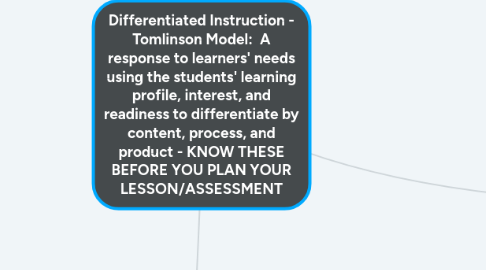
1. Learning Profile: How does the student learn / prefer to learn / learn best?
1.1. Consider: Gardner's 8 Intelligences & Sternberg's 3 Intelligences
1.1.1. visual/spatial, tactile/kinesthetic, logical/mathematical, interpersonal, intrapersonal, naturalist, musical, verbal/linguistic
1.1.2. analytical, practical, creative
1.2. Content: What is being taught / given to the student?
1.2.1. Find different ways to present content to students. examples: maps, charts, videos, movie clips, audio, web resources, music, artifacts, books, pictures
1.3. Process: How is the material being taught / presented? How is the student interacting with the material?
1.3.1. Find different ways for students to interact with the material. examples: group work, simulations, drawings, modeling, lecture, hands-on activities
1.4. Product: What is the student producing? What is the project / assessment / work being completed and evaluated?
1.4.1. Find different ways for students to show what they learned: photo essays, projects, tests, PowerPoint presentations, posters, oral presentations
2. Interest: What topics/areas of study interest the student?
2.1. Content: What is being taught / given to the student?
2.1.1. Include content based on student interest within the unit of student or outside the unit
2.1.1.1. Different areas of focus related to a unit of study. Example: in a weather unit some students might focus on tornadoes others on snow storms. Example of outside the unit: using sports to explain / teach statistics
2.2. Process: How is the material being taught / presented? How is the student interacting with the material?
2.2.1. Find a method to engage students with material in or outside of the content area
2.2.1.1. Orbitals:
2.2.1.1.1. units of independent study, conducted by students and monitored by teachers. 3-6 weeks. with log of activities and presentation component.
2.2.1.2. Centers:
2.2.1.2.1. different from stations
2.2.1.2.2. students do not need to complete every center
2.2.1.2.3. Learning centers: collection of activities/materials to teach, provide practice on, or extend knowledge/skills/understanding
2.2.1.2.4. Interest centers: motivate students' exploration of topics.
2.2.1.2.5. Centers should- focus on learning goals, promote growth, reach a variety of levels (content and activities), have clear directions, offer instructions for what to do when work is complete, have a record-keeping system to monitor student work completion and quality of student work, use formative assessment
2.2.1.3. iSearches:
2.2.1.3.1. based on student-centered inquiry
2.2.1.3.2. Phase 1 - students immersed in motivating theme with instruction and activities before forming iSearch questions - "What more do I want to learn?"
2.2.1.3.3. Phase 2 - students develop research plans and identify useful resources
2.2.1.3.4. Phase 3 - follow plans and revise if needed
2.2.1.3.5. Phase 4 - prepare papers that later become oral reports
2.3. Product: What is the student producing? What is the project / assessment / work being completed and evaluated?
2.3.1. Connect to student interest in and outside of the content area
2.3.2. choice boards and learning menus are ways to differentiate product based on student interest
3. Readiness: How prepared is this student to learn this material independently?
3.1. Content: What is being taught / given to the student?
3.1.1. Does what the student receives match his/her readiness?
3.1.1.1. Use leveled texts, provide scaffolding, work toward independent learning
3.2. Process: How is the material being taught / presented? How is the student interacting with the material?
3.2.1. Do the teaching methods / strategies used match the students' readiness?
3.2.1.1. Cubing: 6 sides of a cube used to differentiate activities, provide different perspectives, brainstorm
3.2.1.1.1. Students can create cubes / use dice
3.2.1.1.2. Can have different cubes for different students / groups based on readiness
3.2.1.2. Tiered Assignments: different assignments based on the same learning goals/objectives that focus on the main ideas of a unit
3.2.1.3. Compacting
3.2.1.3.1. especially useful for high-achieving students
3.2.1.3.2. pre-assess students to determine mastery. 100% on assessment is not required
3.2.1.3.3. exempted from instruction and activities from topics they already know
3.2.1.3.4. activities given to extend content
3.2.1.4. Learning Contracts
3.2.1.4.1. often used with compacting
3.2.1.4.2. clear directions for work, expectations, criteria, and timeline for completion
3.2.1.4.3. activities are self-directed
3.3. Product: What is the student producing? What is the project / assessment / work being completed and evaluated?
3.3.1. Is support offered to help students complete assignments and assessments?
3.3.1.1. Extra time
3.3.1.2. Reading support
3.3.1.3. Larger font sizes

